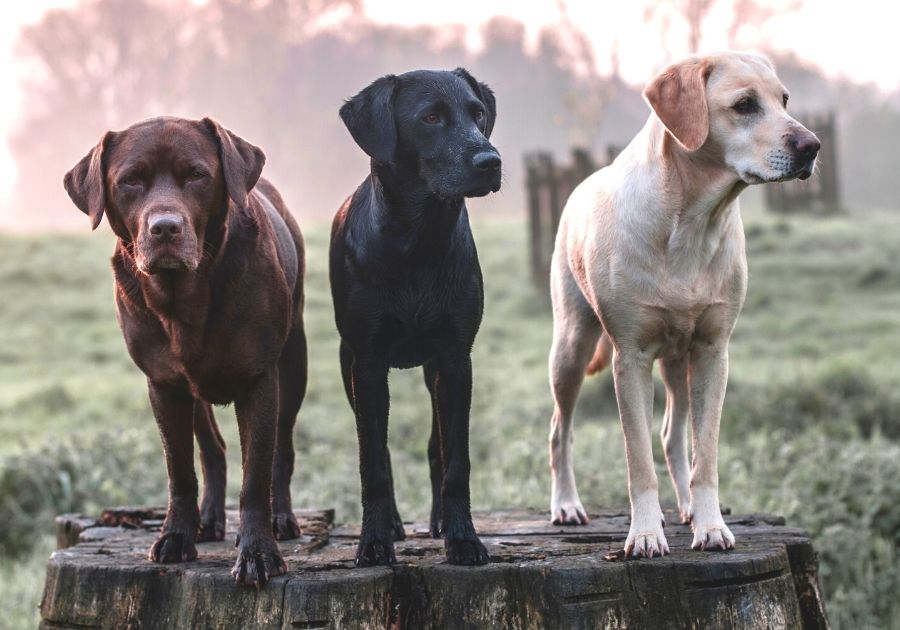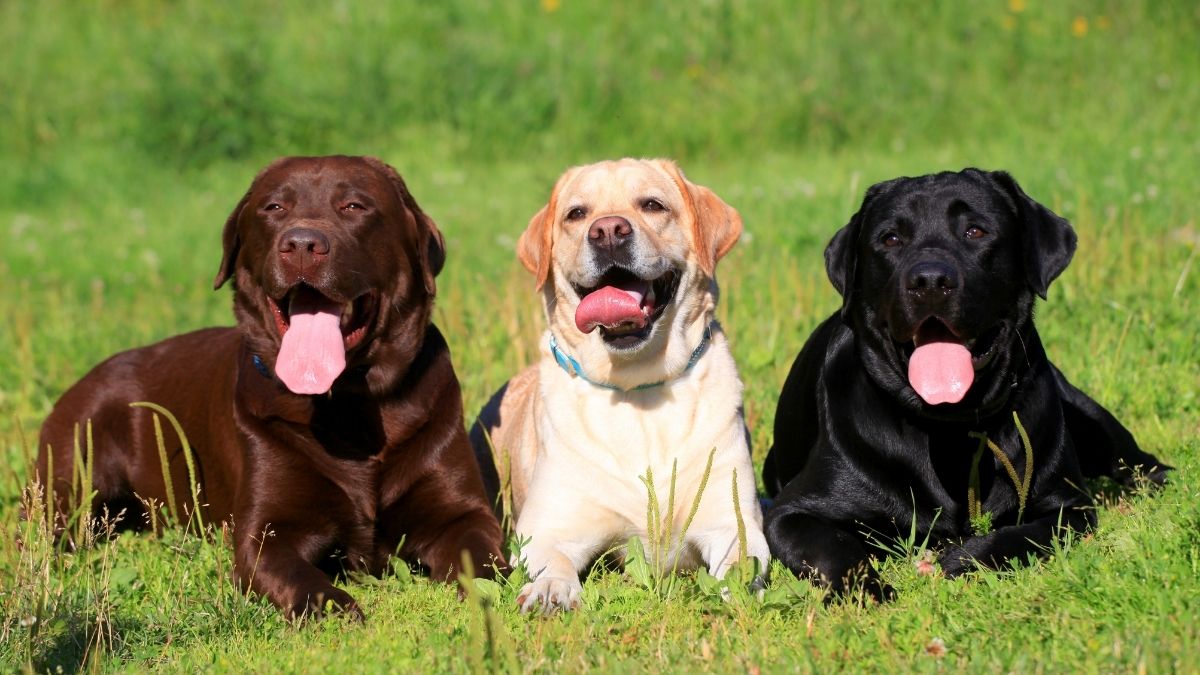The Labrador Retriever is a dog breed in high demand, and the one factor pet parents consider when choosing a Lab is the coat color.
For some people, it isn’t much of a fuss and choosing any of the Labrador colors depends on personal preference.
Others, however, have deep-seated beliefs about the Lab colors and wonder whether color can influence temperament.
These concerns bring up an important question: Is there a color that’s better than others?
In truth, non of the Labrador Retriever colors is the best of all. That said, there are some distinctions amongst each color, and some pet parents believe it affects temperament.
These distinctions have made people develop theories about the breed colors, and these theories influence choices.
The rest of this article will break down our answer into details.
How Many Labrador Colors Are There?

According to the American Kennel Club and other major kennel clubs, the Labrador Retriever breed has only three standard colors: black, yellow, and chocolate.
The Kennel requirements state that the colors stay solid, with no spots. Only these three colors are recognized.
However, other non-standard colors are fast rising in popularity amongst breeders and pet parents. These colors are fox red, silver, white, cream, charcoal, and Dudley.
Also, each of the Labrador Retriever colors comes with a particular theory that many people accept as true.
We will also look into the different theories to better understand the perceptions that come with each color.
Black Labrador Retriever

The Black Labrador Retriever is the most common color and has been so for centuries.
This color type has a dominant gene represented by B, which accounts for its being more in number.
Black Labradors are the direct descendants of St. John’s Dog and worked with fishermen to retrieve them.
Black Labs sometimes have a white patch on the chest, which is acceptable.
The Black Lab being the most popular, it is easier to find, breed, and use in shows. They are also used more in hunting and championships.
This increases the positive expectations people have of this Lab color variant.
Because it is common, breeders are more likely to find two healthy parents with a good temperament, even if the parents aren’t of the same color.
If a breeder breeds a black Labrador with a chocolate Lab, for example, there’s a higher chance of getting more black puppies in the litter.
Thus, the theory of the black Labrador is that it is the healthiest, most intelligent, best behaved, and has the best work ethic of the three.
This isn’t always the case, however. Some breeders will want to take advantage of the black Lab’s popularity to sell faster, neglecting health and temperament.
To get the best of any type of Labrador, find a reputable breeder.
Chocolate Labrador Retriever

Chocolate Labrador Retrievers are the rarest of the three standard Labrador colors, and fans of this color type love the attractive nature of the coat.
This color type first came into the doggy scene in 1892 but got popular in the 1930s.
The chocolate Labrador Retriever has a recessive b gene, and only Labs without the dominant black B have a chocolate color.
Chocolate Labs come in different shades, from a lighter color to a dark brown, and they should not have any tan markings or white stripes.
They can be lighter or darker, but do not have as many shades as the Yellow Labrador. The only diluted variant of the chocolate color variant is the Silver Labrador.
Chocolate Labradors have the least positive reputation. They are seen as highly energetic and the most hyper of all three color types. This reputation is because it is harder to find two good chocolate Labs to breed.
However, there is no scientific evidence to back up the claim that the chocolate Lab is more energetic.
Some chocolate Labradors are just as calm and mellow as the black Labrador. Again, it depends on the breeder and how well you train your Lab.
Chocolate Labs also make good hunters just as much as the Black and Yellow versions.
Healthwise, however, the chocolate Lab is at a loss. According to experts, Chocolate Labradors have the shortest life expectancy and are more prone to illnesses like exercise-induced collapse and allergies.
Yellow Labrador Retriever

Though the newest of all the three colors, the yellow Labrador is the second most popular color.
The popularity is more likely because of the different non-standard colors that are a dilution of the yellow, all of which are gaining in popularity.
The yellow Labrador Retriever has genetics different from both the Black and Chocolate Labs.
Yellow Labs have a recessive gene ‘e’ that blocks the Black ‘B’ gene or Chocolate ‘b’ from manifesting.
This can only happen if there is no dominant ‘E’ as that can’t block the black or chocolate colors. Yellow is the newest color of this breed and was first seen in the early 20th century.
The Yellow Lab could take on a very light shade, becoming white or creamy. It could also have a tinge of red, which leads to the Fox Red color variant.
Then there are the Dudley Labradors that looks pinky, almost like albino dogs.
Yellow Labradors are also common because they are considered friendly, playful, and social. Many therapy Labrador Retriever dogs are yellow.
Non-standard and Rare Labrador Colors

The non-standard and rare Lab colors are believed to be influenced by a color dilution gene that makes the standard colors appear in different ways.
These colors are not officially recognized by the American Kennel Club or any other major kennel club in the world.
- Silver Labrador: Dilution of the chocolate
- Charcoal Labrador: Dilution of the black
- White Labrador: Dilution of yellow
- Fox Red Labrador: Dilution of yellow
- Dudley Labrador: Dilution of yellow
Does Each Color Have a Specific Role?
While there isn’t a designated role for each color by any kennel club, preferences have made it seem so.
The Yellow Lab looks friendlier and more accomodating than other colors, that’s why it is picked for emotional support and other services like guiding the blind. Yellow Labs are also good to show dogs because of their attractive color.
Black Labs are often chosen for hunting expeditions, and also trial competitions. Because there’s a higher likelihood of the Black Lab getting the best of traits, participants of trial competitions opt for it.
Chocolate Labs don’t have a specific role attached to them. You can find them in shows, on the hunting ground, and even amongst service dogs. They have the highest flexibility.
Non-standard colors are not usually preferred for any duty other than being household pets. It is harder to register once for a show or competition, and hunters boycott non-standard colors.
Which Labrador Color is the Best?
While we strongly assert that no Lab color is the best, we know there are different areas where all three are compared.
To make the choice easy for you, we will look into these different areas and see if any color type has the biggest advantage.
Intelligence
The debate on which Labrador color type is the most intelligent has raged on amongst pet parents for a long time.
We all want a pet that ranks high in intelligence, so this is a determining factor for many people.
Because the black and yellow Labrador Retrievers are often used for work, hunting, and other services, the common belief is that they are more intelligent than the Chocolate Lab.
However, intelligence has little to do with coat color and is influenced more by breeding. This is where chocolate Labs have more issues.
Because chocolate Labs are the least popular, many backyard breeders are more concerned with getting the color and do not consider the intelligence and health of the parents involved.
This leads to many chocolate Labs that seem dumber than other color types. These are flaws, though, not the general rule.
Health
The belief here is that the color coat has no influence on health, and that is technically true.
However, just as we explained in the area of intelligence, chocolate Labradors often find themselves at a disadvantage compared to the other two.
The chocolate Lab has an average life expectancy of 10.5 years while others live up to 12 years.
Bad breeding is the main reason for this, and experts warn the general public not to assume that the color gene has something to do with the shorter lifespan.
Again, because chocolate Labs are the rarest of the standard colors, they are harder to breed.
According to findings on the subject, “Breeders targeting this color may therefore be more likely to breed only Labradors carrying the chocolate coat gene…this narrows the gene pool and may result in a higher proportion of genes conducive to ear and skin conditions.”
Recommended:
Labrador Retriever Exercise: How Much Is Enough?
Temperament
In terms of temperament, the common belief is that yellow Labradors are the kindest and sweetest, black Labradors are calm and mellow and chocolate Labs are highly energetic.
However, this belief remains a myth and has no scientific backing. In reality, training and breeding are what make it seem like each color type has a distinct temperament.
The black Lab is usually well-bred, which gives it a calmer disposition.
Yellow Labs are often trained to be service dogs, so kindness is prioritized.
Chocolate Labs don’t have any specific focus and suffer more from bad breeding, which is why they have a bad reputation.
But there are chocolate Labs that are kind, calm, and good-natured.
Final Thoughts
Regardless of any of the Labrador colors you opt for, some basic requirements are needed.
You should ensure you shop from a reputable breeder as that would lessen the risk of getting a Lab with poor qualities, regardless of the color.
Training and doggy care also help bring out the best in your pooch.
Featured Image: Farinosa / Getty Images







